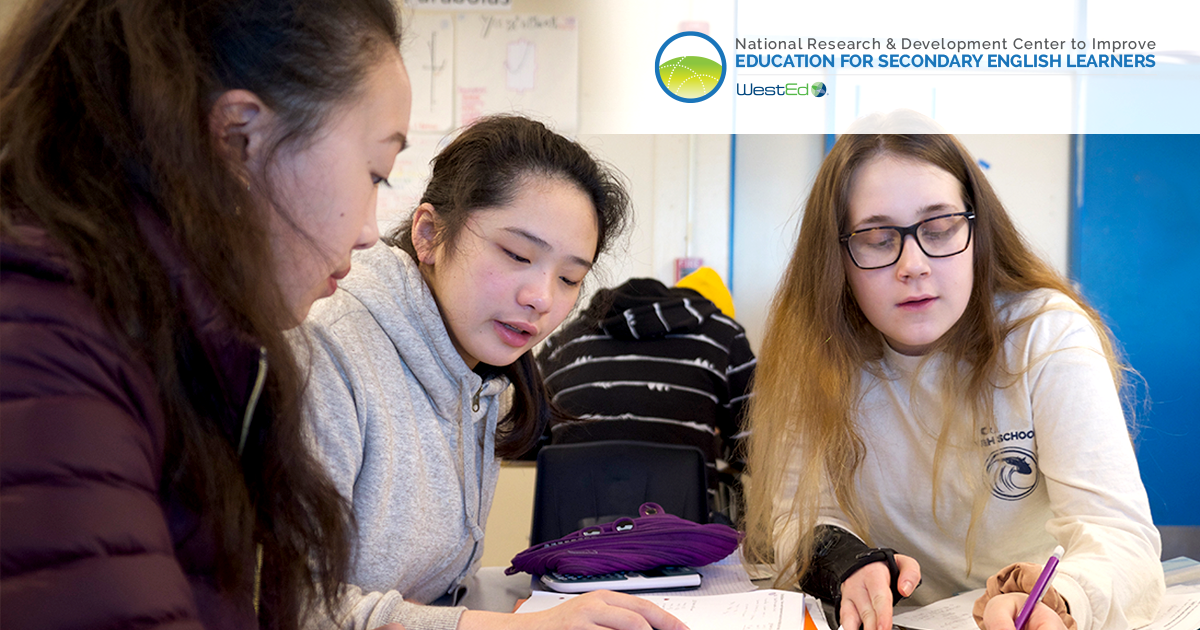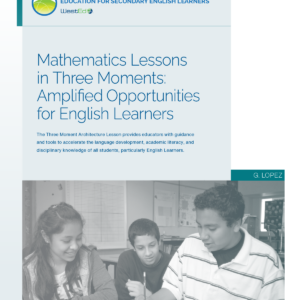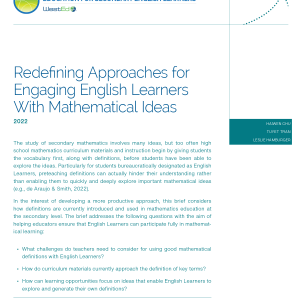How to Engage English Learners in Mathematics: Q&A with Dr. Haiwen Chu
Posted on

 Research on math instruction reveals that some lesson designs contribute to deeper and more meaningful learning for all students, particularly those still learning English. Learn more in this conversation with Dr. Haiwen Chu, co-principal investigator at the National Research and Development Center to Improve Education for Secondary English Learners. Dr. Chu is currently leading a study called Reimagining and Amplifying Mathematical Participation, Understanding, and Practices, or RAMPUP, which will evaluate the impact of a rising 9th grade summer bridge math program on enabling English Learners to learn math and language simultaneously.
Research on math instruction reveals that some lesson designs contribute to deeper and more meaningful learning for all students, particularly those still learning English. Learn more in this conversation with Dr. Haiwen Chu, co-principal investigator at the National Research and Development Center to Improve Education for Secondary English Learners. Dr. Chu is currently leading a study called Reimagining and Amplifying Mathematical Participation, Understanding, and Practices, or RAMPUP, which will evaluate the impact of a rising 9th grade summer bridge math program on enabling English Learners to learn math and language simultaneously.
EL Center: You have some exciting research-based recommendations for teachers and teacher educators. Before we get to them, how has your research informed your recommendations?
Dr. Chu: We have conducted field trials the past two summers, looking closely at the structure of classroom activities and how that structure enables students to develop understanding of concepts. We have been able to document how students’ conceptual understandings develop over time and how their language changes—as they, for example, learn different ways to describe patterns they see.
EL Center: Given your findings, how should math educators approach lesson planning, especially when serving students who have not yet fully learned English?
Dr. Chu: Overall, we want English Learners to understand not just how to do something, but why, when, and under what conditions to apply or adapt those mathematical procedures. All students are capable of deep and generative conceptual understanding if we offer them opportunities to explore and deepen their knowledge.
Lesson planning starts with being clear about the goal—what we want students to know and be able to do. We recommend identifying ambitious goals for deep conceptual understanding of math. For any given lesson, this requires clearly identifying what that deep conceptual understanding is, characterized by the connections that they [students] can make. For example, take the average of a set of data. There is, of course, a well-defined procedure: add up numbers and divide by the number of data points. However, mechanically carrying out the procedure does not constitute understanding of what it means or how it works. So, the question for teachers becomes: What are those generative concepts that encompass the procedure—that put the procedure into a context that can be easily understood, and eventually, extended?
You could think of average in terms of a group of people clearly sharing a number of objects. This practice is common in our lives. When students observe us pooling all our objects together and dividing by the number of people to share, they can develop a deep, meaningful conceptual understanding of average. We sometimes call this the moment of the lesson—when students interact with the concept. This is where students make connections across procedures, representations, scenarios, and other ideas in deep and meaningful ways. This stage has to be very carefully orchestrated—it will not happen by accident—only if students are deeply challenged and supported to make connections.
So, the concept behind the mathematical practice becomes the heart, or core, of the lesson.
Next, we want to lead students as they journey toward fully appropriating the mathematical meaning. The second step in lesson planning is preparing the learner. This requires teachers to step back and pinpoint real, lived connections students already bring in the door to that concept; what would make them care about it? Thus, the question for teachers is: How do I set up activities that create engaging student interactions with each other that invite and entice them to bring in lived experiences, ideas, and scenarios? That is: How do I tap into students’ experience around fair sharing or equal sharing?
Finally, to really own the concept and math practice, students need opportunities to extend their understanding to new scenarios or genres. Extending understanding is where students demonstrate and stretch their depth of understanding—when we give students opportunities to connect to previous scenarios or develop a new application. In our example of average, teachers could introduce a new character who brings in a new quantity of objects, thereby shifting affecting the overall total and the average.
In short, I have just described the Three Moment Lesson Architecture: 1) preparing the learners; 2) interacting with the concept; and, 3) extending understanding.
EL Center: Now, why is language so important in a math classroom?
Dr. Chu: To express and negotiate ideas involved in analytic practices, students need to use language. Language is a funny thing; it can be both what we are currently thinking and the medium through which we will soon think more deeply. Talking with peers makes it much more likely that all students will develop deep understandings.
Notably, this approach will allow English Learners to simultaneously learn math and language, so they can advance faster in all subjects than they otherwise would. The key, of course, is providing the right level of scaffolding.
This is the art of teaching; when learning is well-constructed and well-implemented, it is hard to see the seams between activities. Everything should weave together harmoniously, and one task should flow into the next—all building a coherent narrative over time.
EL Center: How can teachers optimally engage groups of students in deep and meaningful thinking and conversation, considering different levels of English proficiency?
Dr. Chu: We know from the literature, and our development work corroborates, that teachers should approach activity planning by looking at three structural dimensions: 1) grouping formats; 2) activity structure; and, 3) language offered. Most importantly, teachers need to make sure that the prompt they are using to stimulate student discussion elicits multiple responses and approaches. If it elicits a clear right or wrong answer, it simply will not generate the kind of discussion we are seeking. For example, “Tell me about a time you were supposed to share something, but it became an unfair situation,” will generate many varied responses. Students will be able to draw from lived experiences—things they deeply care about.
Using an open-ended prompt that is directly tethered to the lesson’s main point will generate many useful choices for teachers. Of course, teachers need to consider the amount of time activities will take. Having students work in small groups takes more time than having the entire class work as a team, but the former approach may be worthwhile as students benefit from formulating and exchanging their own ideas with each other. That is a dimension of proofing.
Then there is structure—how we set up the terms of engagement so that all students participate and contribute—not just who is called upon. For example, in a group of four, a teacher could have students do a round-robin in which each student relates their ideas, without interruption, before the group comes to consensus and reports out.
EL Center: What does it look like when a teacher increases the intensity of scaffolding across these interactions?
Dr. Chu: The most prevalent approach to providing low-intensity scaffolding around a discussion involves the teacher asking a question, allowing for some individual thinking time, and then calling upon students to respond. This approach favors kids who are quick. Instead, my co-authors Jill Neumayer DePiper, Leslie Hamburger, and I encourage teachers to at least use a moderate level of scaffolding, like the round-robin example I just gave. This approach supports participation by all students, as all students are required to take a turn.
The most intense level of scaffolding might have many more steps. For example, pairs of students take turns explicitly comparing and contrasting their ideas, or connecting their ideas, before each is asked to share not what they said, but what their partner had to say. That kind of structure will take more time, but students will benefit from that additional time, as it provides the opportunity for them to hear others’ ideas and experiences and develop the intersubjectivity that assists in hearing and responding to others.
All in all, these three dimensions—grouping, structure, and language—offer teachers choices about how to proceed. Sometimes, teachers will be able to go faster; other times, students will need more time and support. There is no one right way of doing things; these are options.
We have found that the more we diversify structures and groupings, the more students begin to appropriate the structures themselves; for example, becoming familiar with how to do a round-robin, saving time.
This is the art of teaching; when learning is well-constructed and well-implemented, it is hard to see the seams between activities. Everything should weave together harmoniously, and one task should flow into the next—all building a coherent narrative over time.
To receive regular Center updates and findings, subscribe to Where the Evidence Leads newsletter.
The Institute of Education Sciences (IES), U.S. Department of Education, supports this research through Grant R305C200008 to WestEd. The opinions expressed are those of the authors and do not represent the views of the Institute or the U.S. Department of Education. IES is the statistics, research, and evaluation arm of the U.S. Department of Education. IES is an independent and nonpartisan organization created by the Education Sciences Reform Act (ESRA) of 2002, and it is the leading source of rigorous education research and evaluation. It consists of the National Center for Education Research (NCER), the National Center for Education Statistics (NCES), the National Center for Education Evaluation and Regional Assistance (NCEE), and the National Center for Special Education Research (NCSER).


